Cyrus Klepcys Mars: Bringing Home The Red Planet
You wake up to a loud beeping in your ears and an excruciating pain in your side.
“What happened?” you ask yourself.
Suddenly you remember where you are, and the horrible reality of your situation comes flooding back. There was a violent sandstorm and you were hit by flying debris. Your crew had to abandon their posts and flee to safety. Your shelter is still there, but you don’t know if that is going to matter.
Why wouldn’t it matter? Because you are stranded on Mars.
This is how the bestseller book The Martian begins: with its protagonist, Mark Watney, waking up to discover he has been stranded on the red planet during a hasty evacuation thanks to a dangerous sandstorm with high winds and a rogue antenna having impaled him.
His first words prove he doesn’t immediately see the bright side of the situation. Anyone who has read it will know exactly what I mean, and to everyone else: just go read it.
The Martian was recommended to me by our very own Ian Skellern, and it did not disappoint as the best reality-based science fiction novel I have ever read.

XKCD looks at ‘The Martian’
That is a bold claim, but it stands because of the sheer amount of detailed accuracy in this novel. It is so thoroughly thought-out that there are only minor plot holes. And these have not come about due to lack of imagination, but rather perhaps a slight error in math. That is incredible.
What is even more incredible is that a movie of the novel (I am definitely a cinephile), directed by Ridley Scott and staring Matt Damon, is due to be released in October 2015. This fall can’t come soon enough. In the meantime, let us take our own trip to the Mars in another way – with an incredible watch.
What did you think I would say?
Here we are going to discuss a timepiece from a brand that may be off the radar for some watch fans. The brand is Cyrus, an independent whose beginnings resulted from a collaboration with master watchmaker Jean-François Mojon.
That name should ring a bell: Mojon is the man behind such pieces as the Harry Winston Opus X (see The Harry Winston Opus Series: A Complete Overview From Opus 1 Through Opus 13), the Urban Jürgensen P8 caliber with pivoted detente escapement (see Heartbeat: Urban Jürgensen Montre Observatoire Enamel), and the MB&F LM1.
The watch by Cyrus that will bring us to the red planet is the Klepcys Mars, an awesome dual retrograde timepiece with a miniature rotating Mars beneath the crystal.
I think that our fictional Mars castaway, Mark Watney, would approve of having a timepiece that could give him a satellite-eye view of the planet he is stranded on. Though you’ll have to read the book or wait for the movie to know how Watney deals with his situation, I can explain how the Klepcys Mars works right now.
It all begins with the dual spinning disks in the center of the dial. These are the indicators for minutes and seconds, and they make up a large part of the dial.
The second disk (dead center) is obviously continuously running, while the minute disk boasts two minute scales around the circumference.
That means it takes two hours for the disk to make one revolution. There is no pointer for the running seconds, so you will have to pick out an arbitrary spot, perhaps even the same one you use for the minutes, if you’d like an exact reading of the seconds.
The seconds disk is more useful for showing the relative speed of the larger, concentric minute disk and to immediately know if the movement is wound.
The minute disc rotates with no real fixed point of reference, either, but it does have a pointer moving slowly in a 180-degree arc on the left side of the dial. This pointer carries the hour blocks.
The arc that the hour blocks trace covers twelve hours; upon reaching the top of the dial, the blocks instantly fly back to the bottom to begin the journey again.
The blocks act as a pointer for the hours, registered on the left side of the dial, but also as a pointer for the minutes, which would be read as they slowly pass the blocks on the right.
That is the reason that the minute disc has two scales on it. Since the hour blocks rotate 180 degrees and double as the indicator for the minute disc, upon completing its retrograde action it will be on the opposite side of the minute disc. If the disc had only one scale, it would show that the time is at 30 minutes past the new hour, which isn’t true.
So Cyrus had to make a double scale that takes twice as long to move so that once the hour blocks return to their starting position they will also be reading the correct time in minutes. This means the time is always moving, figuratively and literally.
I think Mark Watney would find that appropriate, as his fight to stay alive on Mars begins and ends as a race against time.
The hours count
The hour blocks are pretty awesome, if just for simply being two pointers in one, which also happens to have a retrograde function. But they have another secret talent, one that helps you know whether or not it is day or night (on Earth).
Granted, you can usually just look outside. But, technically, this display also functions as a 24-hour indication and more specifically as a day/night indicator. Talk about multipurpose components.
The way it shows day versus night is with color. The two blocks are lined up side by side and boast alternating colors of red and white (on the Klepcys Moon these are blue and yellow). These blocks rotate halfway through the twelve-hour arc at 6 o’clock, which is a nice average time to switch from day to night or night to day.
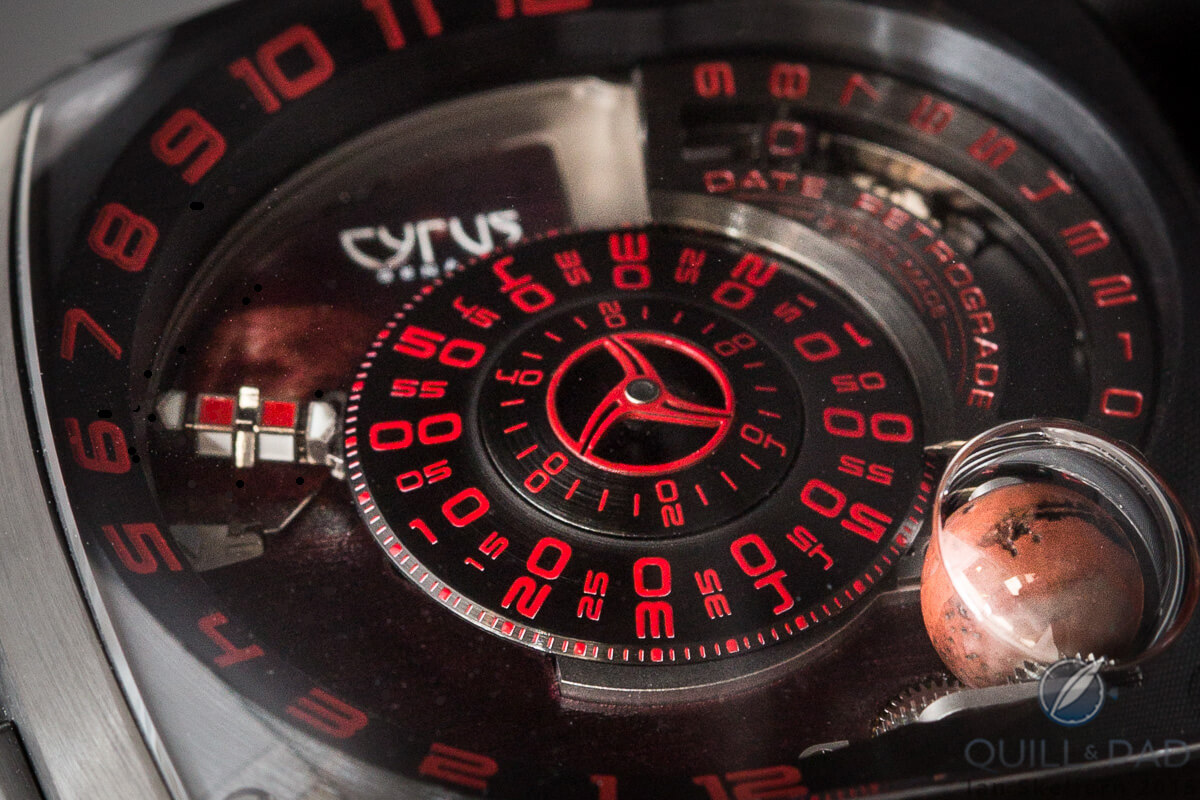
Close up look at the dial of the Cyrus Klepcys Mars: you can see the miniature Rubik’s Cube-like block pointer indicating 00 on the left
The block rotates via a spring finger that comes up from under the dial and is caught by a four-pronged star between the blocks. The spring finger is pressed against a stop while the blocks go past 6 o’clock, causing the rotation of the blocks.
During the retrograde motion, the spring finger is pushed out of the way by the four-pronged star so that the blocks do not change early on the return trip. This is actually similar to how a detent escapement is only advanced in one direction of the balance wheel’s rotation – thanks to a spring finger, which is free to move in one direction only.
At one point in The Martian, Mark Watney is trapped in a sandstorm and his only option is to move in one direction as well. Fitting.
The days follow
Those hour/day/night block indicators are also very useful for setting the retrograde date that takes up the top right quarter of the dial, extending down to around 4 o’clock.
The reason is that if you own this watch, knowing when the date function is changing over (usually somewhere between the hours of 9:00 pm and 3:00 am) is critical so that you don’t attempt to adjust the date and possible damage internal components.
I would say this could be considered the fifth and final function of the hour blocks. Busy guys, don’t you think?
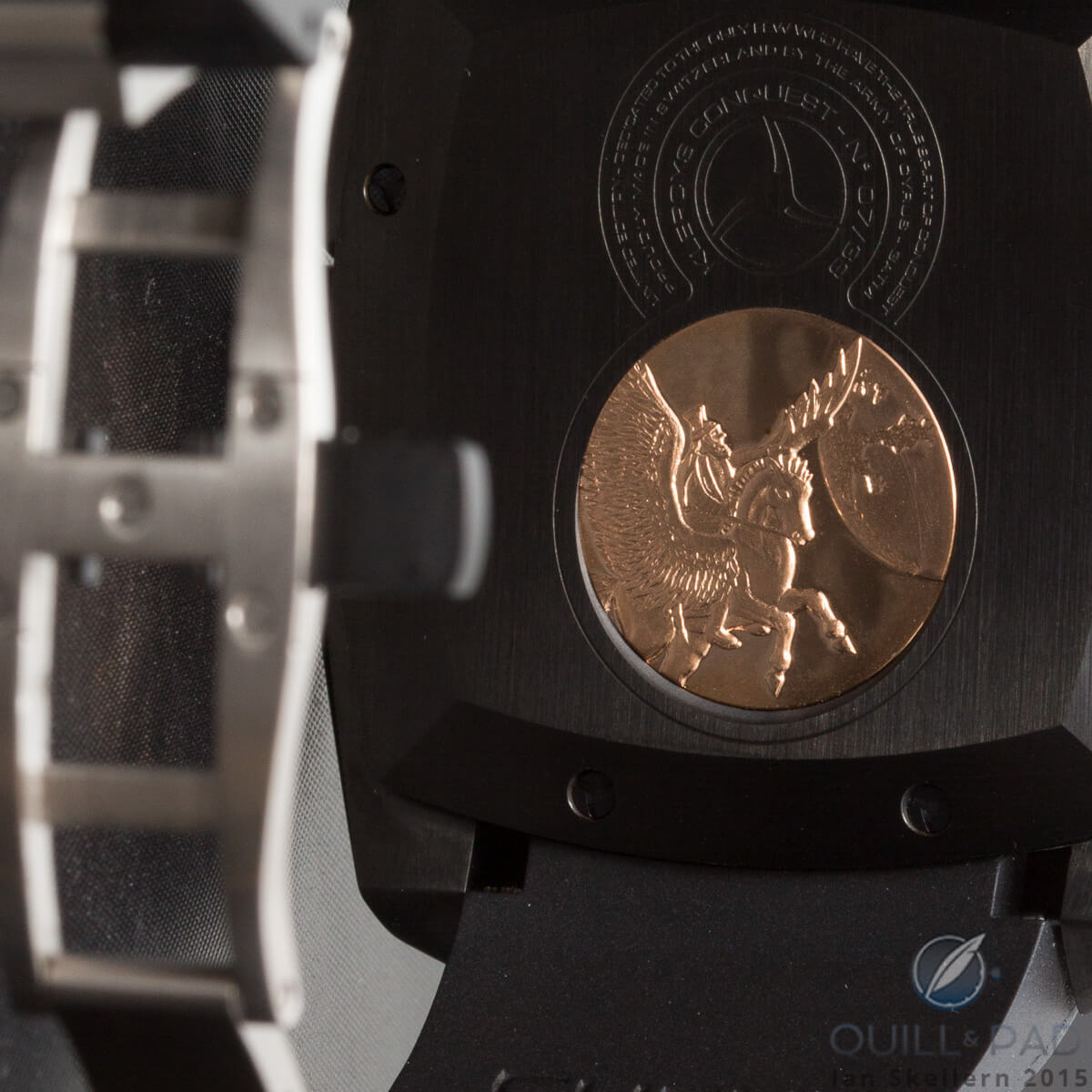
This hand-engraved medallion on the back of the Cyrus Klepcys Mars depicts Cyrus on a winged horse setting off to conquer the planet Mars; this is a copy of an actual coin dated from Cyrus the Great’s rule more than 2,500 years ago
The retrograde date is rather delightful in its function, because it doesn’t simply climb to the top and return at the end of the month. No, the scale on the date function only goes from 0 to 9. This means that the numeral actually must reset every ten days, and the “pointer” is in itself a scale block. Numbered 0 through 3 on its four sides, the date block rotates every time it returns to 0, which would be the start of another ten days.
Even more impressive is the fact that that is not the most complicated aspect of it. Since the end of a month can be the 31st, and the number 1 is actually second on the scale, every third time the date block climbs the scale it must pause for a day at the 1 and rotate the block in position to switch from 31 to 01 before continuing.
This makes the system magnitudes more difficult since creating a pause and a rotation not tied to the retrograde movement of the date block means you cannot simply use the same strategy as the hour blocks’ rotation.
Mars connection
The final complication is my favorite part of the watch. Granted, the watch is fantabulous already. But this addition always sets a watch apart from the crowd: the three-dimensional rendition of Mars.
In the original version of this watch, the Klepcys Moon, this miniature sphere is a moon (who would have guessed?) that is stationary with a black half-sphere rotating around it. This causes the depiction of the moon phases.
But since Mars is a superior orbiting planet relative to Earth (meaning its orbit is outside of our orbit), it doesn’t really have phases like the moon does.
To make this function, well, have a function, Cyrus removed the black half-sphere and reworked the gearing to make the miniature Mars rotate. Instead of the half sphere rotating every 29.5 days based on a lunar period, this new Klepcys version sees Mars rotate for the duration of a Martian day.
A sidereal day on Mars (relative to Earth’s time) is approximately 24 hours, 37 minutes, and 22 seconds. And that is precisely the time it takes for the small Mars sphere to complete a rotation. This means the rotation shifts by a little more than 37 minutes every day, and the sphere will not be back to the same side showing at the same time of day for 38.5 days.
The fictional mission controllers for Mark Watney’s mission must also shift their schedules back that amount every day so that they work during the actual day on Mars.
If Watney wanted a good visual indicator of his days, he could have this watch strapped to his wrist to keep an eye on the little Martian sphere to make sure he is staying true to the Martian day.
Or he could look outside.
The little details
One of the final details topping off the Mars connection is the addition of the famous “face of Mars,” which was first seen by the Viking 1 orbiter in 1976. Thanks to a low resolution photo of a rock formation in partial shadow which was taken by Viking 1, a great mystery was born.
Did aliens leave a message for us or was it proof of life living there now? Years later, after thousands of conspiracy theories developed, clearer photos were taken and the mystery was solved: it was, in fact, just a rock formation in partial shadow. Oh, shucks.
Well, the makers of this watch knew this face still holds a lot of sway over the imaginations of space enthusiasts, and so it added a reproduction in miniature in the top left corner of the dial, which looks rather true to the more accurate modern photography.
If you can’t have the man in the moon, you might as well have the Mr. of Mars.

Cyrus Klepcys Mars featuring a three-dimensional red planet at the bottom right that makes one revolution in a Martian day
Overall, the watch is a very interesting timepiece, and would be a great one to wear while reading (or soon watching) Andy Weir’s The Martian. I highly recommend that you take a look not only at the book but at this increditastic watch that has all sorts of interesting things going on. It is definitely out of this world!
Was that a little too much? Oh well, how about the breakdown!
- Wowza Factor * 9.42 A rotating Mars, double retrograde functions for the hours and date, plus the five-fold purpose of the hour/minute/day/night indicator makes for a super wow that you can’t help but utter.
- Late Night Lust Appeal * 94.2 » 923.786m/s2 This is some serious G force we are pulling, enough to kill you if it is sustained! And that is exactly how awesome this watch is.
- M.G.R. * 65.6 Movement co-developed by Jean-François Mojon with double retrograde function, miniature accurately rotating Mars, it holds its own for miles.
- Added-Functionitis * Serious The Mars day takes the cake on this one. It is a huge horological swelling, especially combined with that awesome retrograde date. This definitely calls for prescription strength Gotta-HAVE-That cream for this Martian swelling.
- Ouch Outline * 11.68 –Getting your hair caught in a power mixer! Hasn’t happened to me, thank heavens, and actually not even to anyone I know. But I’ve seen it, and it is terrible. But if it got me this watch…I might have to take one for the team!
- Mermaid Moment * 24 hours, 37 minutes, and 22 seconds! That extra 37 minutes and 22 seconds seems small, but it really adds up to a happy life! Now where did I leave the limo rental number?
- Awesome Total * 529.6 Add the number of components in the movement (456) to the number of editions (33 x 2) followed by the size of Mars in mm (7.6) and you get a solid awesome total!
For more information, please visit www. cyrus-watches.ch.
Quick Facts
Case: 48 mm, titanium or DLC-coated titanium
Movement: automatic Caliber CYR598
Functions: hours, minutes, seconds; date, day/night indication, length of Martian day
Limited: 33 pieces each titanium and black DLC-coated titanium
Price: $105,900 in titanium and $106,900 in DLC-coated titanium





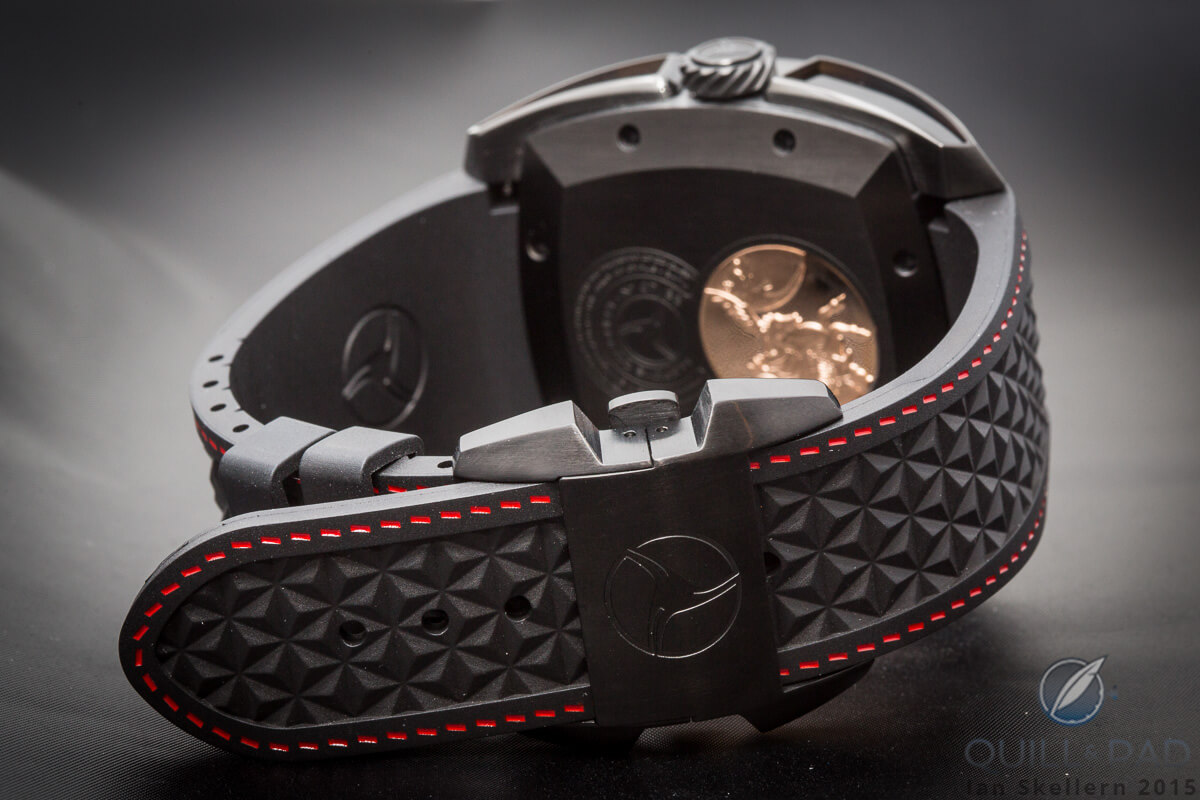
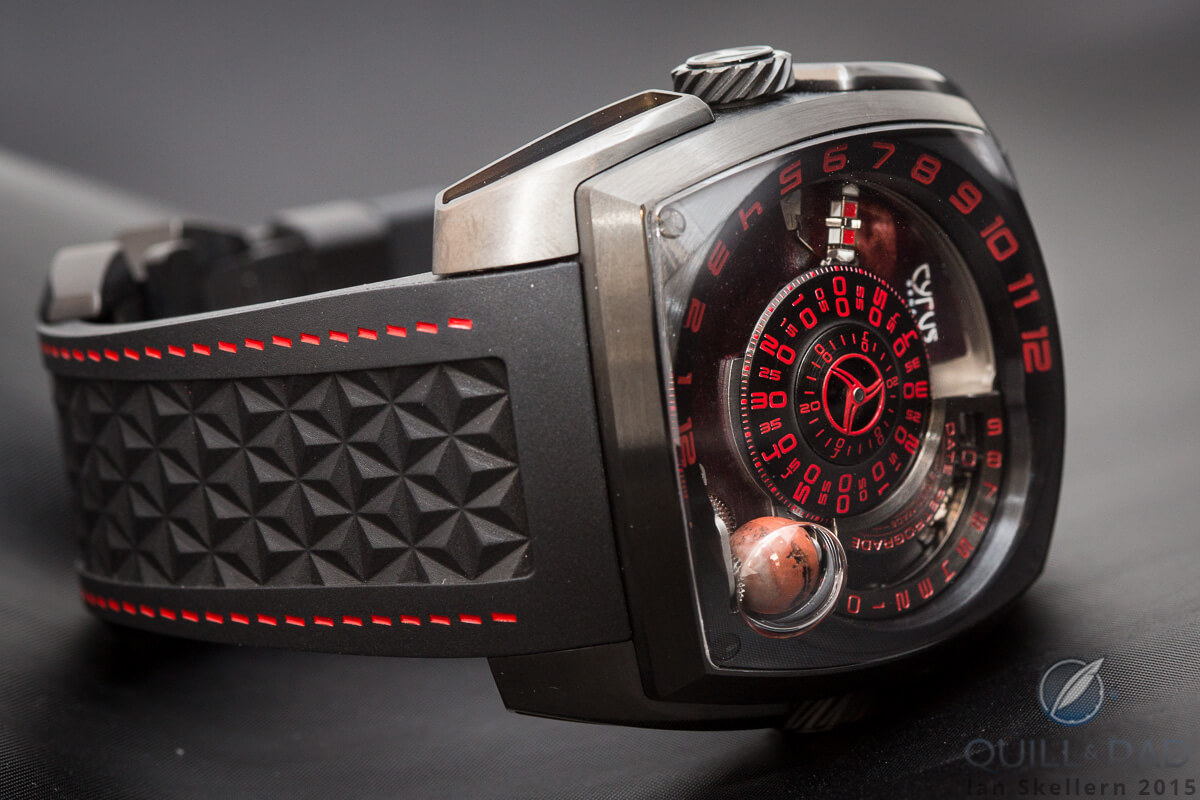
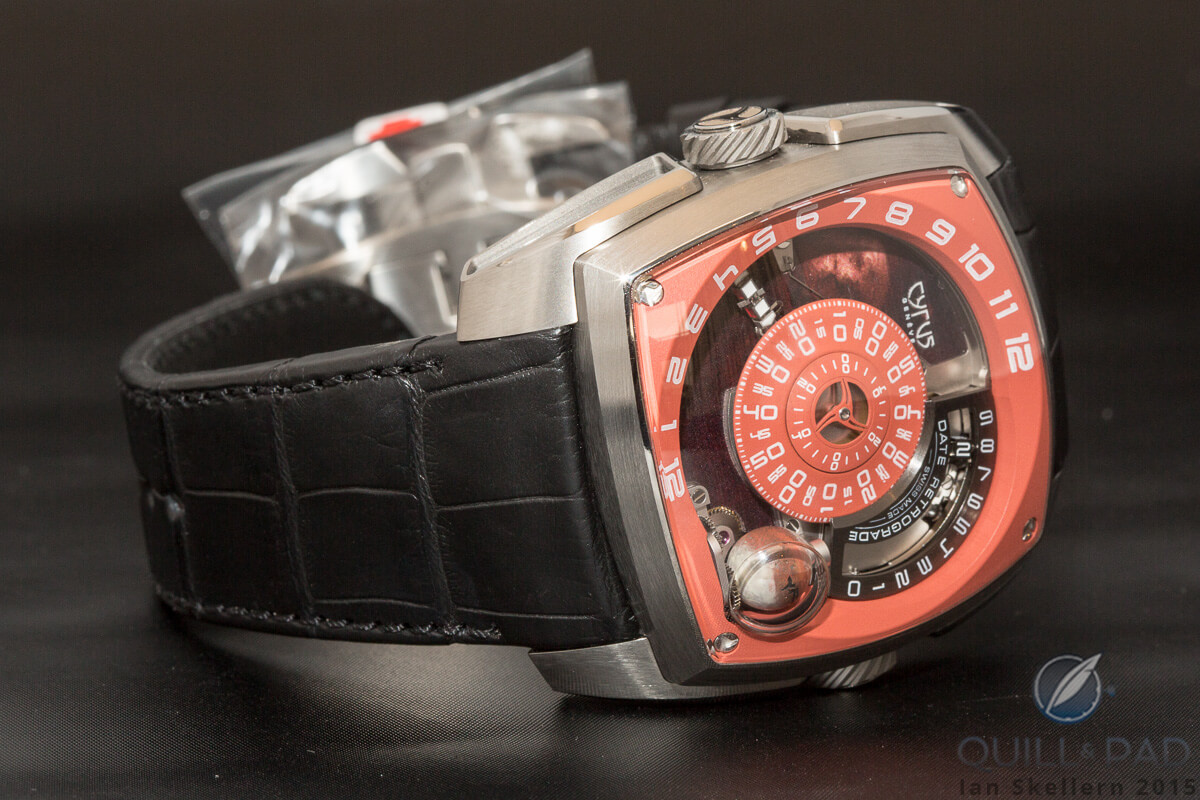



Trackbacks & Pingbacks
[…] Cyrus Klepcys Mars (see Cyrus Klepcys Mars: Bringing Home The Red Planet), even utilizes a rather complicated retrograde date that doesn’t move in a simple one-direction […]
Leave a Reply
Want to join the discussion?Feel free to contribute!